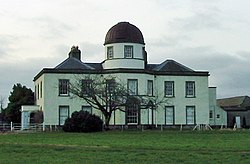Dunsink Observatory
| Dunsink Observatory | |
|
County Dublin | |
|---|---|
 Dunsink Observatory | |
| Type: | Observatory |
| Location | |
| Grid reference: | O10653870 |
| Location: | 53°23’13"N, 6°20’15"W |
| History | |
| Built 1785 | |
| Observatory | |
| Information | |
| Owned by: | Dublin Institute for Advanced Studies |
| Website: | www.dunsink.dias.ie |
The Dunsink Observatory is an astronomical observatory established in 1785 in the townland of Dunsink in County Dublin, outside the city of Dublin itself.[1]
The most famous director of the Observatory was Sir William Rowan Hamilton, who, amongst other things, discovered quaternions, the first non-commutative algebra, while walking from the observatory to the city with his wife. The annual 'Hamilton Walk' that commemorates this discovery begins at the observatory. He is also renowned for his Hamiltonian formulation of dynamics. In the late 20th century, the city encroached ever more on the observatory, which compromised the seeing. The telescope, no longer state of the art, was used mainly for public 'open nights'.
Dunsink observatory is currently part of the Dublin Institute for Advanced Studies. It provides accommodation for visiting scientists and is also used for conferences and public outreach events. Public talks on astronomy and astrophysics are given regularly at the observatory by professional and amateur astronomers. Stargazing events are also held using the Grubb telescope.
History
The observatory was established by an endowment of £3,000 in the will of Francis Andrews, who was Provost of Trinity College Dublin at his death on 18 June 1774. The site was established on the south slope of a low hill in the townland of Dunsink, 276 feet above sea level.
The South Telescope or 12 inch Grubb, is a refracting (uses lens) telescope built by Thomas Grubb of Dublin, completed in 1868.[2] The achromatic lens, with an aperture of 11.75 inches, was donated by Sir James South in 1862, who had purchased the lens from Cauchoix of Paris 30 years earlier.[3] He had intended it for a large but troubled equatorial that came to fruition in the 1830s, but was dismantled around 1838.[4][5]
The entry for the observatory in Thom's Directory (1850) gives the following account of the observatory,
| “ | ASTRONOMICAL OBSERVATORY OF THE UNIVERSITY OF DUBLIN, DUNSINK This Observatory, endowed by Francis Andrews, esq., LL.D., Provost of Trinity College, and erected in 1785, was placed, by statute, in 1791, under the management of the "Royal Astronomer of Ireland," an appointment first filled by Dr. Henry Ussher, and subsequently by Dr. Brinkley, Bishop of Cloyne. The Institution is amply furnished with astronomical instruments, and is open to all persons interested in astronomical science, on introduction to the resident Assistant. It is situated in Lat. 53° 23' 13" N., Long. 6° 20' 15" W.[1] |
” |
Dublin Mean Time, the official time in Ireland from 1880, was the mean solar time at Dunsink, just as Greenwich Mean Time was the mean solar time at Greenwich Royal Observatory in Kent. Only in 1916 did Ireland move to Greenwich Mean Time. In 1936, Trinity College stopped maintaining the observatory and rented out the land. Éamon de Valera, who had established the Dublin Institute for Advanced Studies in 1940, added a School of Cosmic Physics to it in 1947, partly in order to revive the observatory, for which it was given responsibility.
A chair at Trinity College Dublin, the Andrews Professorship of Astronomy, was associated with the director of Dunsink Observatory during the time that the Observatory was part of the College.
Outside links
References
- ↑ 1.0 1.1 Thom, Alexander: 'Irish Almanac and Official Directory' 7th ed. (1850) p. 258
- ↑ The South Telescope of Dunsink Observatory Authors: Wayman, P. A. Journal: Irish Astronomical Journal, vol. 8(8), p. 274 Bibliographic Code: 1968IrAJ....8..274W
- ↑ History of the Cauchoix objective
- ↑ "The Observatory of the Late Sir James South". Astronomical Register 8: 196–199. 1870. Bibcode: 1870AReg....8..196..
- ↑ South, James: Dictionary of National Biography, 1885-1900, Volume 53, "South, James", by Agnes Mary Clerke
- "The Andrews Professor of Astronomy of Astronomy (1783)". School of Physics. Trinity College Dublin. https://www.tcd.ie/Physics/research/themes/astrophysics/research/andrews-prof/index.php.
- Wayman, P. A. (March 1986). "The Andrews' Professors of Astronomy and Dunsink Observatory, 1785–1985". Irish Astronomical Journal 17 (3): 167–183. Bibcode: 1986IrAJ...17..167W. http://articles.adsabs.harvard.edu/full/1986IrAJ...17..167W.